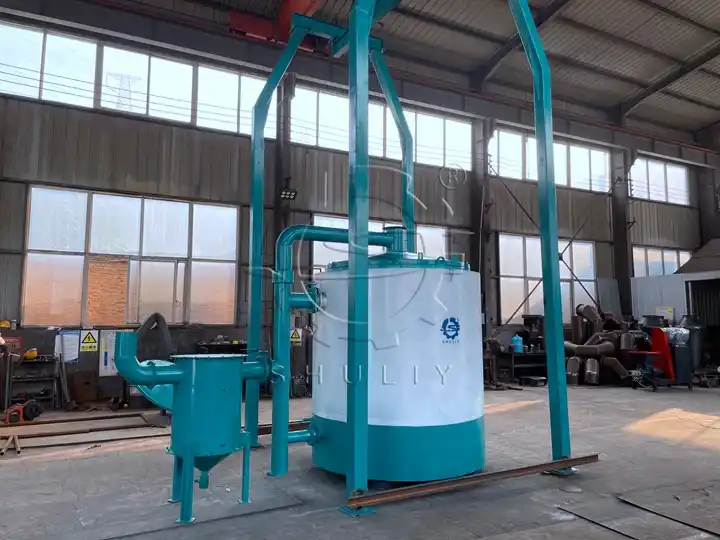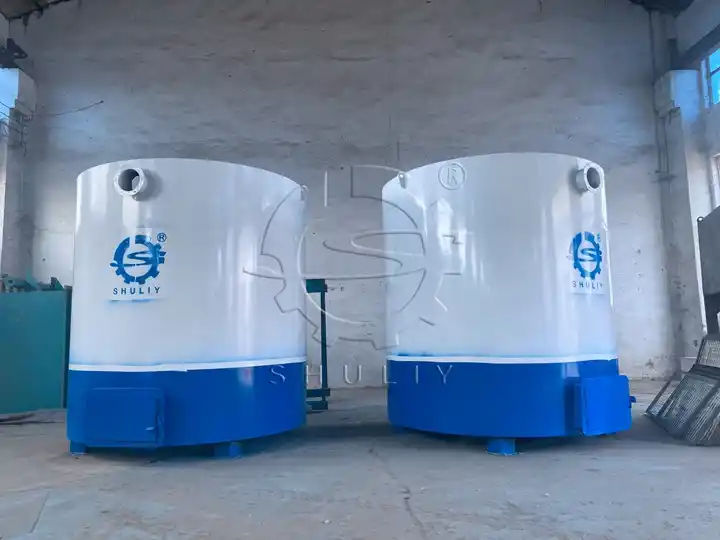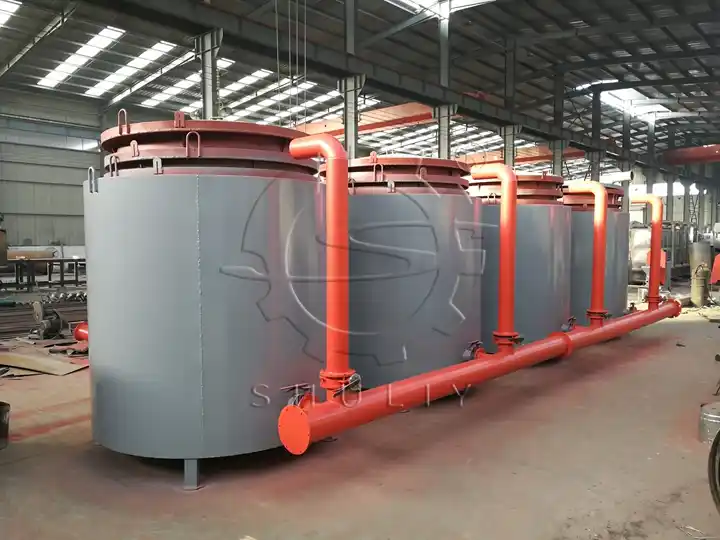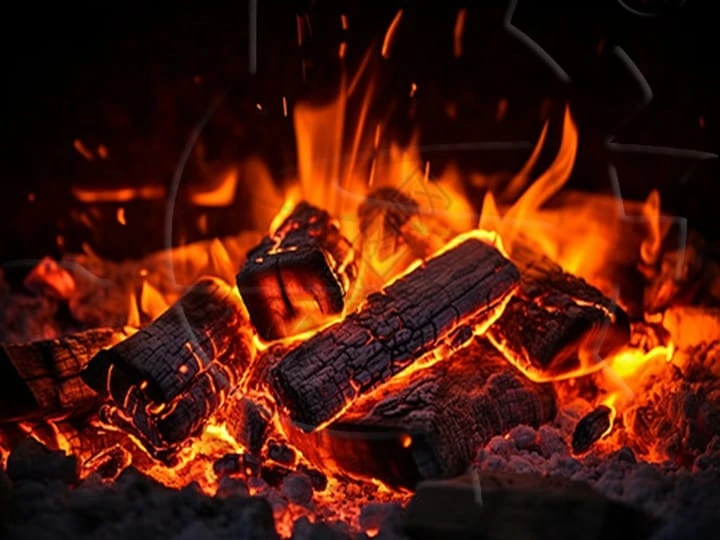Какая температура необходима для карбонизации древесины? – Вертикальная печь для карбонизации
Вертикальная углефикационная печь, также называемая висячей углефикационной печью, является одним из широко используемых эффективных устройств для углефикации. Она может точно контролировать температуру на разных стадиях, достигая высокого выхода и стабильной углефикации. В процессе производства угля контроль температуры является ключевым фактором для эффективности углефикации и качества угля.
Правильное управление изменениями температуры не только увеличивает коэффициент преобразования древесины, но и снижает энергопотребление и оптимизирует время углефикации.


Процесс углефикации и стадии температуры
| Диапазон температуры печи | Ключевые моменты эксплуатации | Описание |
|---|---|---|
| ≤ 90 °C | Воспламенение отходами, яркое пламя | Обеспечить начальное тепло, подготовиться к стадии удаления влаги |
| 90–150 °C | Снизить пламя | Ввод влаги удаление стадия, испарение внутренней влаги из дерева |
| 150–230 °C | Увеличить пламя | Продолжать удаление влаги около 6 часов, обеспечить равномерную сушку |
| 230–280 °C | Поддерживать стабильное горение | Начать сгорание помощь, генерация газовой смеси |
| ≥ 280 °C | Закрыть нижнюю дверь, стадия самовоспламенения | Циклическое движение CO и горит внутри, внешнее тепло не требуется |
| До ~500 °C | Углефикация завершена | После углефикации, остудить более 10 часов для наилучшего результата |
В вертикальной углефикационной печи весь процесс обычно делится на пять стадий: нагрев, удаление влаги, помощь воспламенению, самовоспламенение и охлаждение. Связь между температурой и контролем горения показана в таблице ниже.
Во время углефикации внутренняя влага древесины постепенно испаряется, летучие газы выделяются, и структура древесины превращается в стабильный уголь. Особенно когда температура достигает примерно 280 °C, печь может использовать горючие газы, которые она сама производит, для самовоспламенения, что значительно снижает энергопотребление и обеспечивает энергоэффективное, экологически чистое непрерывное производство.

Как содержание влаги влияет на температуру углефикации؟
Чем выше содержание влаги, тем медленнее нагрев
- Вода в древесине при нагревании поглощает значительное количество тепла для испарения, что замедляет рост температуры печи.
- Содержание влаги 10–15%: температура печи растет быстро и может перейти в стадию углефикации в короткое время.
- Содержание влаги 25–30%: потребуется больше времени на удаление влаги, и процесс углефикации задерживается.
Температура на стадии удаления влаги зависит от содержания воды
- В вертикальной углефикационной печи 90–150 °C — стадия обезвоживания древесины.
- Высокое содержание влаги → удаление влаги требует 6–8 часов;
- Низкое содержание влаги → Только 3–4 часа нужно, чтобы завершить.
Слишком быстрая подача тепла приведет к неравномерной углефикации
Если древесину нагреть напрямую выше 230 °C, не полностью удалив влагу, легко получить неравномерный уголь, примесь цвета или даже трещины древесины.
Таблица согласования температуры и влаги на разных стадиях
| Стадия Температура | Необходимое содержание влаги | Ключевые моменты эксплуатации |
|---|---|---|
| Ниже 90 °C | Любой | Воспламенение отходами, начать подготовку к удалению влаги |
| 90–150 °C | Влага ≤ 30% | Поддерживать слабое пламя, медленно испарять воду |
| 150–230 °C | Влага ≤ 20% | Увеличить пламя, полная дегидратация, дерево начинает небольшое разложение |
| 230–280 °C | Влага ≤ 15% | Перейти в стадию помощи сгорания, генерация газовой смеси |
| 280–500 °C | Влага ≤ 10% | Самовоспламеняющаяся углефикация, формирует высококачественный уголь |
Преимущества контроля температуры в вертикальной угольной печи
- Вертикальная печь для угля оснащена автоматической системой контроля температуры и устройством рециркуляции газа, что обеспечивает точное и энергосберегающее углефицирование:
- Когда температура печи ниже установленного значения, система автоматически воспламеняется, чтобы дополнить тепло.
- Когда температура печи достигает 280 °C, образующийся внутри печи угарный газ самовоспламеняется, обеспечивая тепло, создавая самоподдерживающуюся углефикацию.
- Печь имеет прочную герметичность, эффективно препятствует обратному току воздуха и снижает теплопотери.
- Этот дизайн делает весь процесс углефикации безопаснее и экономичнее, особенно подходит для материалов с высоким содержанием влаги или разнообразного сырья.


Рекомендованное содержание влаги древесины
Существует близкий динамический баланс между содержанием влаги древесины и температурой углефикации.
- Слишком высокая влажность удлиняет время удаления влаги и увеличивает энергопотребление.
- Слишком низкая влажность может привести к слишком быстрой углефикации и хрупкости структуры угля.
В вертикальной углефикационной печи идеальным является высушивание сырья до содержания влаги 10–15%. Это не только сокращает время углефикации (примерно 14 часов горения 10 часов охлаждения), но и производит уголь высокой плотности, низкого содержания золы и высокого качества.
Почему выбирают вертикальную углефикационную печь?
По сравнению с традиционными земляными печами или простыми печами, вертикальная углефикационная печь имеет следующие преимущества:
- Точная настройка температуры: обеспечивает равномерную углефикацию и более стабильное качество угля.
- Высокая эффективность: может углефицировать 2 500–3 000 кг сырья каждые 24 часа.
- Энергосбережение и экологичность: использует самогенерируемые горючие газы для циркуляции, дополнительное топливо не требуется.
- Чистые и низкие выбросы: получается меньше дыма, более экологично.
- Широкий диапазон исходного материала: подходит для древесины, бамбука, кокосовой скорлупы, скорлупы пальмы, ореховой скорлупы и других биомасс.

Углефикационная эффективность
При правильном контроле температуры вертикальная углефикационная печь может производить уголь высокого качества с высокой плотностью, хорошими пусковыми характеристиками и однородной формой. Можно выполнить несколько партий за один день, что значительно повышает производительность.

Какая температура необходима для древесной углефикации?
Крайний диапазон температуры для углефикации древесины составляет 150 °C–500 °C. С точной системой контроля температуры вертикальной углефикационной печи вы можете легко достичь высокого качества и стабильного производства угля.
